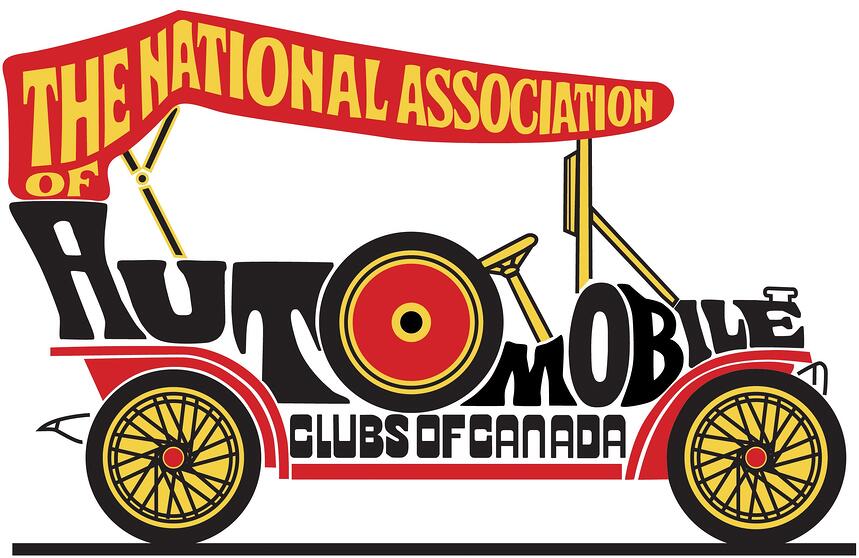Early track records are commonly disputed. Outlaw tracks didn’t even bother to keep records. Stopwatches and early timing clocks were often unreliable. Observers’ memories are filtered by personal loyalties. Arnett acknowledges a degree of underreporting where the accomplishments of a group of Mexican-Americans from San Diego was concerned. But that’s okay, they have a barn full of trophies and their memories. Records, we don’t need no stinking records.
Verifiable dates and numbers exist, such as on January 18, 1953, the Bean Bandits’ Class C roadster won at Santa Ana with a speed of 135.13 mph. In April of that year, the Bean Bandit Mark II – a streamlined, modified roadster/dragster — won the first Southern California Championships at Pomona Raceway with a top speed of 132.35. Also in April, the Bandits’ D/Competition rear-engine flathead roadster ran a record 142.98. Peggy Hart, promoter C.J. “Pappy” Hart’s wife, won the top time of the day, 112.95, in the Bean Bandits’ Cadillac powered roadster on May 10, 1953. Arnett set a speed of 142.98 on October 5, 1953, at Santa Ana breaking the prior record of 140.08. In August of 1957 at the Colton Anniversary race, the yellow slingshot took the Top Eliminator title doing 154.63 mph with a time of 9.78.
These numbers don’t tell the complete story. Bench racing these days lets Arnett know the battles he won without even trying. A racer from Sacramento recalled his first experience with Arnett’s crew. “I’d heard of the Bean Bandits. When they came up here, I just kept my car in the trailer. After they made one run, I didn’t take it out.” Arnett hears lots of stories like this, “We knew we were heavy duty at that time.”
Bean Bandit, Carlos Ramirez, grew up with Arnett and watched his car madness start. “He studied a lot. He knew the motor. When we were kids, we’d walk up Market Street and Joaquin would pick up an old coil or something that was laying in the road. He’d take it home and take it apart and see what made it work.” Ramirez started driving with Arnett years before they were allowed. “We learned how to drive when we were quite young, probably 8 or 9 years old. We used to sneak the cars out of our yard when our dads at work.” Along with Andrew Ortega and Arnett, Ramirez piloted the club’s entries. “I drove every car he ever built. I drove dragsters and I drove the midgets for a few years. I went to Bonneville, went to the lakes -I went all over.” And went as fast as he could. Club member, Harold Miller, recalls Ramirez’s driving: “He didn’t know how to stop. He wanted to do good, so he’d push it past the envelope.”
Starting in 1948, Arnett raced with the Road Runners and the Southern California Roadster Club on the dusty surfaces of Muroc and El Mirage. In 1951 he and his friends started their own club. Comprised of kids from his neighborhood, their ranks reflected the composition of the multicultural environment of their home. While they had African-American, Caucasian, Japanese and Lebanese members, they were mostly Mexican-Americans and they flaunted it proudly, calling themselves the Beaners. During a reflective moment, club member Billy Galvin (who designed the original “Bean Bandit” logo) spurted out that outlaws liked beans, and the Bean Bandits were born.
Paradise Mesa Airfield, outside of San Diego was one place where the Bean Bandits built their memories. It became their home track. Paradise Mesa was a strip where illegal racing was restricted following what, in 1951, Hot Rod called “hazards of frequent uncontrolled drag meets.” Bean Bandits’ president, Mike Nagem, helped form the San Diego Timing Association (SDTA) and convinced property owner Henry Adams to create a legal venue for racers to show off their abilities. He agreed and the SDTA, with the help of local law enforcement officers, organized the country’s first legal drag strips. SDTA brought needed order to a world of chaos. They instituted track rules, charged entrance fees and used Otto Crocker’s reliable timers. The track officially opened in 1951 and before closing 8 years later, young Arnett and his friends cleaned up with the trophies. Arnett recalls hopping into his car and racing the fastest vehicles there, motorcycles.
Harold Miller sits comfortably in Arnett’s living room and remembers the Saturdays 45 years ago when the Bean Bandits would meet at Mike Nagem’s service station on Pacific Coast Highway. After filling up on tortillas, meat, cheese, jalapenos and abalone from the nearby fish market, they’d fire up the cars and Ramirez could practice driving. “One time he was in a car and he burned rubber. He was going so fast he couldn’t stop. I never will forget that. The lord was with us. Carlos went up a hill and when he got to the corner he was going so fast, he just went flying through a busy intersection. I thought he was gonna get killed.”
Maybe the cars Arnett built from scratch resembled scrap metal to the casual observer. He would “get a piece of pipe and bend it around and weld the rear end on it.” Whatever chassis was available, a ’27 T or ’24, Arnett would just throw a motor in the front. “We used to take the tires off of Andrew’s convertible and put them on the damn thing and go out racing.” Maybe those guys who purchased installation ready speed equipment never thought they had to worry. In his book, Drag Racing: Yesterday and Today, Wally Parks credited the “colorful kids” for their racing equipment and further pointed out they were “usually good for a laugh or two.” Well, maybe their competitors were laughing to hide their tears because from 1951 to 1956 the “colorful kids” managed to hold records at each of the Southland’s tracks. Miller remembers fellow racers would hate to see the guys with yellow car show up. “They’d all say, ‘Well, we’re gonna race for second, because these guys are gonna kick our butts.'”
Arnett’s scavenger hunt for more performance led him to ‘old man Olson,’ a model plane dealer who had fashioned rocket boosters for bombers during the war. Arnett purchased liquid horsepower from him in the form of nitromethane. While he was not the first racer to use it, he learned to get the most bang for his buck. Arnett experimented with nitro in a motorcycle at El Mirage. “I went 150 on a big old Harley Davidson that weighed five times more than I did. That was in ’52, ’51. It was pretty fast for then. It scared me.”
Respectful of the new fuel, the Bandits arrived at the track with their nitro packed in rags. Nitromethane’s not that volatile, but they didn’t know it at the time. Miller says they’d add to the mystique saying, “Don’t go near it, it’s gonna blow up.” Paradise Mesa was their proving ground as Miller recalls, “These guys from LA would come down and make us look bad. Joaq would say, ‘Okay, let’s put the nitromethane in.'” The crew chief finally settled for a 50/50 mixture because, as he told Hot Rod in 1953, “It’s easy to mix this way. A gallon of this and a gallon of that.” Arnett used an array of fuel additives to boost his team’s performance. Other racers’ technical ignorance led to rumors of the Bean Bandits’ melted pistons or corroded engines. Arnett swears it never happened.
Wild rumors aside, the learning curve with the new fuel and oxygen amplifying additives took a toll on Arnett’s hard working engines. He developed alternative means to save parts and keep performance high. Solutions like a gas and oil mix that lubricate the engine when it warmed up were employed. These methods were discovered because he learned a lesson when his engine froze and rods and pistons had to be replaced. He suffered.
Their rough-and-ready equipment didn’t faze driver Ramirez. “That’s one thing I never even thought about. I never thought about getting hurt or something coming loose in the car. I had so much faith in Arnett that I didn’t question it. I would look at something and I’d say, ‘that’s gonna hold. I know it’ll hold.’ It never entered my mind that something would go wrong.”
Maybe he didn’t worry because he liked speed. “There’s no substitute for horsepower. You’re always looking for that edge. Arnett used to find it. He’d tell me, ‘Go for it, Carlos.’ And I said, ‘Okay, let’s go.’ That was the name of the game for me. I’d just hammer it.” The Bean Bandits had to blaze their own trails because it was a young sport and they didn’t have role models. There was no one Ramirez thought he could emulate. “We beat them. Chrisman and Neumeyer, Mickey Thompson, Jazzy Nelson… We lost a few races, I’m not gonna say we won them all. But we won our share.”
“I guess Joaquin saw something that he liked,” recalls Ramirez. Arnett chose Ramirez to drive and taught him how to read a race. “He used to run me off and tell me to ‘go watch those guys and see what they’re doing. Pick up their mistakes.'” Studying their rivals taught Ramirez the best time to shift – before or after his competitors, the physical quirks of the track, the body language of the flagman who set off the racers. Then Ramirez put those skills to work. “The guys would tell me, ‘give it a ride’ and they’d get away and let me concentrate on what I had to do.”
The Bandits’ superior abilities allowed them to race the growing national circuit. At the First Annual World Series of Drag Racing held in October of 1954, the club received an award for engineering achievement. Five of the Automobile Timing Association of America’s judges felt Arnett’s hot rod, built in one month for a low cost of $1,000, merited recognition based on the elements of engineering, speed, craftsmanship, and safety. Only nine of the Bandits’ 30 members trekked the 2,500 miles to Lawrenceville, Illinois where they blew three transmissions, wrecked a chassis and an axle. Despite their problems, the snub-nosed “Bean Bandit” powered by a 296 cubic inch Mercury turned a speed of 127.66, the third highest for the meet.
An award Arnett deserved but never won was for building his dual flathead, V8-powered, steel, full-fender ’29 A sedan which featured a lift-off body that could be converted to a dragster in a matter of minutes. The Bandits ran the car as a sedan with the big engine, small engine, or both engines, then slipped the body off and ran it as a dragster in those three combinations. Instead of recognition, the NHRA revised their rules keeping the car from running, and winning, in six classes. “At Pomona, I ran the dragster and it did 127. That was fast for a two engine flathead dragster,” recalls Arnett. “This thing won 45 trophies so quick, we couldn’t believe it.” The sanctioning body couldn’t believe it either; they restricted the Bandits to four classes. Arnett resisted saying, “Wait a minute, I went through all this work.”
His reputation for building mighty engines traveled farther than the race tracks and dry lakes. Customers with illicit sources of income hired Arnett to hop up their cars to outrun pursuers. The cars looked normal outside but had a belly full of speed. “They wanted fast cars to beat the cops and I built them. I built high-performance engines that went into stock bodies.” As Bean Bandit Billy Galvin says, “We never criticized them. That was their life.” Arnett agrees, “We were all from the same neighborhood.”
The club became local folk heroes. Their renown reached far south of San Diego into Mexico. Admirers in a poor town honored them by sending them handmade peasant clothes “to represent the race.” Arnett laughs remembering the white ‘uniforms’. “We had all white pants that didn’t stay white. Some of the guys had their shirts made out of sack material. Way down in Mexico they didn’t have buttons or a machine to sew buttons, so they would tie them.”
Their trip to the Bonneville Salt Flats in 1952 was their first time outside of California and they were faced with new rules. A stop in Las Vegas brought the young guys face-to-face with Jim Crow laws keeping them from their first visit to a casino. “Joaquin said, ‘Oh the hell with it. We’ll all go in.’ So our army of guys marched in there. I think we scared the guard half to death.” As the only black, Miller was singled out to leave, which he did rather than start trouble. He remembers the other guys went in, but then came right out. They didn’t want to stay. Other times the team encountered people unwilling to accept Mexicans. But like Miller explains, it didn’t stop them, “We just survived. If you love what you’re doing, you can put up with a lot of stuff. Because we were determined to go to Bonneville. We were determined to run good… so no matter what, we went. And I’m not sorry we went. But a lot of times it made it tough.” They found the racial balance to vary and thus their reception in different parts of the country. “We went down to New Orleans and it was all different,” says Arnett, used to the Mexican workforce in his hometown. “The gals working at the hotels were all black. The cooks in the kitchen were black. This was new to us.”
Unlike Stone, Woods, and Cook photographs that generally showed the Willys alone or just the white driver and rarely the black owners, the Bean Bandits were too numerous to miss. Their pictures displayed a jumble of Mexicans, Japanese and blacks. Sometimes they slid past difficulty due to naiveté. When the Bandits arrived in Louisville, Kentucky, a hotel manager changed her mind about having room openings when she saw the crew. Arnett asked her why and she complained ‘some of the guys passed for black.’ Arnett explained they were Mexican. The befuddled manager asked, ‘What the heck’s that?’
They weren’t always on the receiving end of trouble. In the dusty heat at a Muroc Reunion, Arnett recently revealed to Don Rackeman how repaid him decades earlier for a bad deed. The team was working in a Bakersfield motel room and Rackeman told the manager ‘these Mexicans are over there changing an engine.’ The manager tried to stop them, but it was to late. Arnett said, “‘We already did it.’ Then we walked out in the parking lot. Rackeman had a T-Bird and we pushed it in the swimming pool.” Rackeman shook his head, surprised to hear this story after so many years, but still full of praise for the San Diego team.
The Bean Bandits were a large club and everything they did got commented on. Even the things they wished people had never noticed. Miller knew when they pulled up in their Hudson – the only car that fit four guys in the front seat – folks said, ‘what a circus.’ They wished that after setting low time, fastest speed and winning the meet at Santa Ana, everyone hadn’t watched them blow a rod in the Hudson as they drove out the gate.
The guys in the Bean Bandits had fun, traveled around and made history until racing became too expensive. By the early 1960’s they settled down and raised their families. The club has always been firmly supported by and supportive of its community. During their racing days, the Bean Bandits also sponsored local football and baseball teams.
Lately, Arnett visits local schools and colleges to talk about his craft and share his welding secrets. Each time Arnett takes his streamliners to the school, another youngster learns what can be done with hard work and imagination. “They think everything comes out of a factory. They ask, ‘How do you form the nose? How do you know how to do it?’ I told them to look at a baseball’s pattern. If you cut that pattern you can sew a new ball. That’s the way you lay it out, and then you weld it, and then you beat it out.'”
The students Arnett works with get the invaluable experience of learning about the magic of science. One school ran a program and borrowed Arnett’s car. After three months he attended an award ceremony for the scholarship won for the science project centered around the famous yellow car. The kids did thorough research, down to explaining how a blower functions.
The Bean Bandits’ return to racing started with a discovery of the old rear engine, full-bodied dragster parked in a stranger’s yard. It had disappeared from their shop and Arnett and his youngest son, Jeff, happened to spot it years later. Arnett restored the car and ran at the antique drags in Carlsbad in 1988.
Fifteen of the original 30 Bandits are running two streamliners and trying to recapture records earned by either the elder Arnett or his son, the late Joaquin “Sonny” Arnett, at the dry lakes and Bonneville. Jeff thinks this is particularly important as he’s noticed historical articles and videotapes where the Bean Bandits are conspicuous by their absence. While the cars’ bodies are new, the engines are the same. Just how many fuel racers can boast of using the same engine since 1953? At El Mirage Arnett proudly showed off his reliable iron block motor. It is the same motor he put in the roadster in 1952 that went 147 without a blower. It is the same motor that turned 153 in a dragster at an early National Hot Rod event, powering the Bean Bandits to a win before 36,000 spectators. Update equipment? Why? “I have never been to the end with these things. I’ve always got a little more left. So why am I gonna get another engine when I haven’t finished this one?”
The team’s achievements, the strength of their relationships and their lasting memories enrich the Bean Bandit’s and their families lives. Jeff Arnett lived with cars all his life, getting tools as toys for Christmas. For him, the club’s influence was constant. “There was always Carlos and Andrew and Pat Durant and Mike Nagem and Marco. I liked growing up with those guys around me. It was like having an extended family.”
Emory Cook, Jeff’s late uncle, was part of that extended racing family. Married to Arnett’s sister, Cook raced with and against Arnett for many years. According to Jeff, he used to pull his hair out trying to figure ways to beat the Bandits. He’d tell his nephew stories about how “My dad would piss him off. ‘He comes over to where I’m working and he takes my old spark plugs that I think are no good and then he puts them in his car and blows my doors off.’ It used to just twist his nerves.” Certainly by 1956, when Cook began making his own racing history, he’d figured a way to overpower his brother-in-law.
“The best part is knowing the man,” is how Ramirez sums up the ride. “Knowing him and knowing the kind of person he is. And his family. Watching his kids grow up. I’m sorry to say we lost one of them, but it’s all part of racing. It hit everybody hard. I thought Joaquin would give it up after that, but he told me, ‘I’m gonna keep going, Carlos.’ Those things are to be expected, I guess, in this type of business.”
In 1992 Arnett was inducted into the Drag Racing Hall of Fame for his innovations and significance to the sport, but from the start, his brilliance was questioned. He must have heard ‘That won’t work!’ so many times it sounded like a mantra. Every time he was questioned, he’d have to show folks what he was talking about. Fellow racer Don Rackeman recognized that Arnett’s mentality in the sport of automotive racing in the 1950s was far ahead of most of the know-it-alls and equipment manufacturers. Prior to running a race down San Diego way, Rackeman stopped into the Bean Bandit’s garage. “His magneto is sitting on the engine like this, at 30 degrees. He said we’re running 30 degrees. I said, ‘No way.’ So we went back that night and put ours at 33 degrees. My partner Lou Baney wasn’t there, but I told him we ran 33 degrees. He said, ‘No way. Do you realize where the piston is?’ I said, ‘I don’t care.’ Joaquin said it and we did it. He’s one very, very bright guy.”
The story is true – probably. This is how you get ‘facts’ from these guys: Someone starts the story, then it fades into another. The raconteur gets corrected by a nearby listener, then starts in on the middle of a completely different story. Empirical evidence? Not exactly. But these guys were having too much fun to take notes. Who knew 45 years ago when they were out there collecting trophies like prizes in crackerjack boxes that some curious reporter would later ask – exactly which race did you win, who did you beat, at what track, with which car, what time, what speed, was it a record? Had they known, would they have taken notes, would the gravity of what they were doing magically become clear, would it have changed a damned thing? In the end, the details don’t matter, Joaquin Arnett and his Bean Bandits slew track and national records consistently beating their richer and better-equipped competitors. They did it because they had the proof of Arnett’s intuition and knowledge. They did it even though they were laughed at and called the “clown princes”. They did it because, well, because it was fun.
by Leah M. Kerr
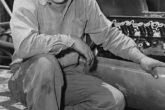


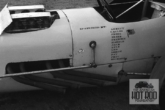

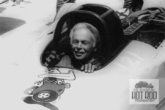
 Art Chrisman
Art Chrisman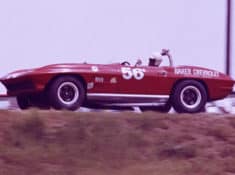 Dick Guldstrand
Dick Guldstrand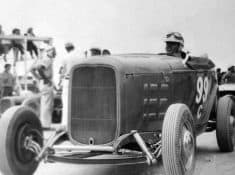 Ray Brown
Ray Brown Phil Remington
Phil Remington

